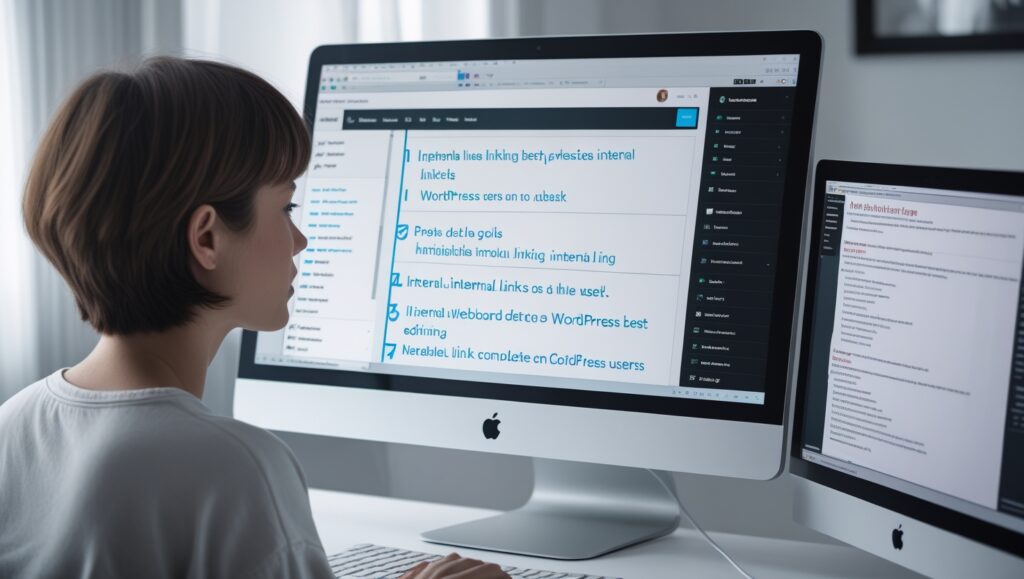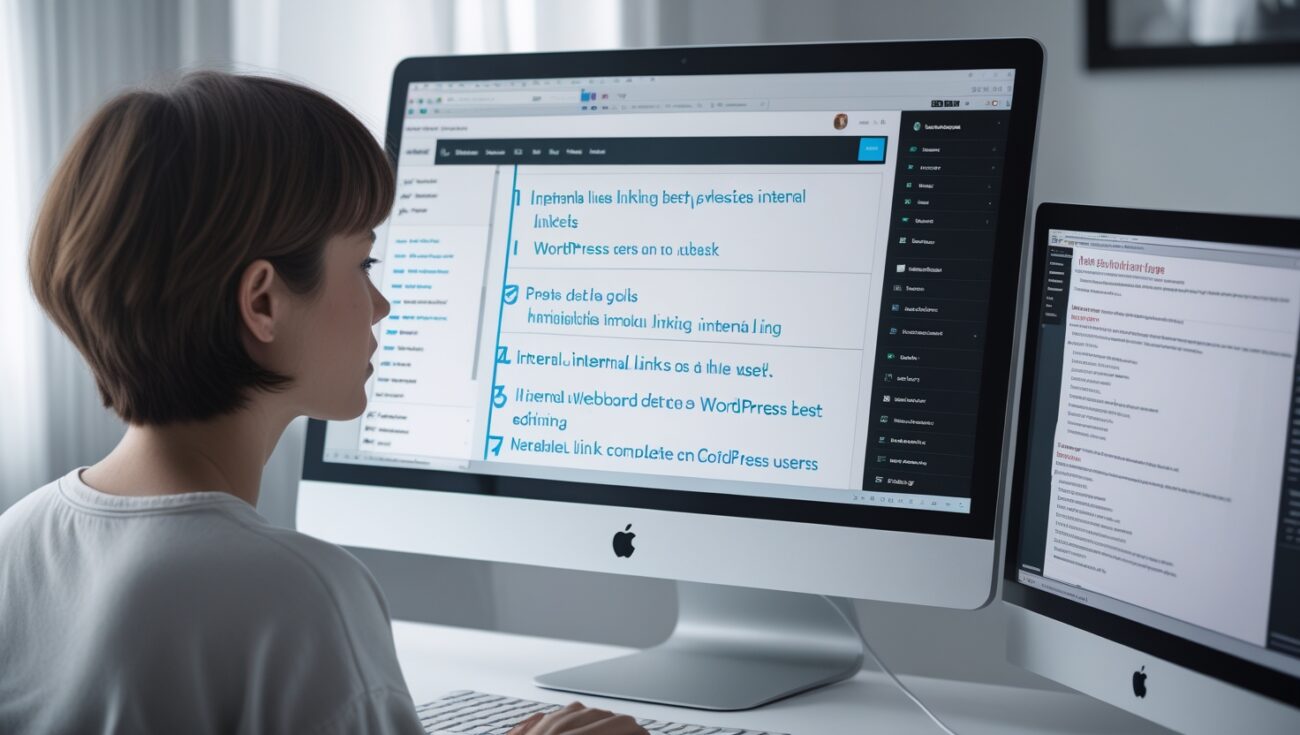Internal Linking Best Practices for WordPress Users
WordPress is an amazing platform, but as a long-time user, I can tell you that its native internal linking features can be a bit clunky and manual, especially on a large website. For years, I would publish a new blog post, maybe add a couple of links, and then I would be done. I had no system, and my website’s ranking suffered because of it.

Table of Contents
It wasn’t until I developed a clear, step-by-step process specifically for my WordPress site that I started to see my rankings climb. This guide is a definitive, easy-to-follow checklist that a WordPress user can use to build a high-ranking, authoritative website. If you’re ready to stop guessing and start building a powerful website structure, this guide is for you.
The Core Principles (Revisited for WordPress)
No matter what platform you’re on, the core principles of internal linking remain the same. The goal is to:
- Improve User Experience: By providing a clear path for your users to find more of your valuable content.
- Boost SEO: By helping Google understand your website structure, passing link equity to your most important pages, and reducing the number of orphaned pages on your site.
The WordPress Internal Linking Best Practices Checklist
Here is a clear, actionable list you can start using on your WordPress site today.
Best Practice #1: Use the Block Editor to Your Advantage
The new WordPress block editor has a great feature that allows you to link to a page by simply typing a word and then adding a link to an existing page. When you type the name of an article, WordPress will automatically provide a list of relevant content. Use this to your advantage to quickly add internal links as you write.
Best Practice #2: Link from New Posts to Old Posts
When you publish a new blog post, make it a habit to link from that post to 3-5 relevant, older articles on your site. This simple act sends new traffic and authority to your old content, which can breathe new life into it.
Best Practice #3: Link from Old Posts to New Posts
This is one of the most powerful things you can do for a new piece of content. Find 3-5 relevant, high-ranking older articles on your site and add a contextual internal link to your new blog post. A link from an authoritative, old post can provide a huge SEO boost to a new one.
Best Practice #4: Use a Plugin to Find Opportunities
A manual process of finding internal linking opportunities on your WordPress site is difficult and time-consuming. You would have to re-read every article on your site and try to find opportunities. That’s why I’ve come to rely on a WordPress plugin to find opportunities for me. A tool can find all of your orphaned pages, broken links, and new linking opportunities.
Best Practice #5: Set Up a Pillar & Cluster Structure
The Pillar & Cluster Model is the most effective way to build a strong website structure on WordPress. The idea is to create a central, comprehensive pillar page on a broad topic, and then write several supporting articles on specific, related sub-topics. Your internal links tie them all together, signaling to Google that you are a comprehensive expert in that niche. A WordPress tool can help you identify your pillar pages and build this powerful structure with just a few clicks.
The Tool That Makes WordPress Linking Easy
The native WordPress features are a great start, but they can be a bit clunky for a large site. Finding orphaned pages, broken links, and new linking opportunities on a site with hundreds of articles is a huge, manual undertaking. That’s why I’ve come to rely on a tool that can automate this for me. Ready to stop the manual grind and start building a high-ranking website today? Discover how Linkbot can help you.
Conclusion: Take Control of Your WordPress SEO
By following these simple internal linking best practices, you can take control of your WordPress SEO and start building a high-ranking, authoritative website. It’s a simple, high-impact strategy that can lead to a huge improvement in your rankings.
My journey taught me that a major mistake is seeing SEO as a mystery. By implementing a smart, corrective approach to my website, I made the mental shift from being a spectator to an active participant in my website’s success. This simple realization took the overwhelm out of SEO and turned it into a series of logical, manageable steps that I could control.
The long-term, compounding effect of fixing these mistakes is what makes it so powerful. Each time you add a thoughtful, relevant link, you are not just performing a task; you are building your website’s authority, one link at a time. These small, consistent improvements add up to a significant competitive advantage over the long term, making your website an increasingly powerful asset.
I can say from personal experience that there is a special kind of satisfaction that comes from seeing a direct correlation between a new link and a ranking boost. It’s the feeling of taking a tangled mess and organizing it into a clean, logical network. The result is a website that just feels better to navigate, for both users and the people managing it.
A clean internal link profile also has a huge impact on your website’s overall trustworthiness and authority. When a user or a search engine bot lands on your page and sees a clear network of interconnected, relevant articles, it signals that you are a serious, comprehensive resource on the topic. This kind of professional organization is exactly what Google looks for.
The most important part of this foundational skill is building a consistent habit of linking. It’s not about a single audit and then forgetting about it. A good website is a living thing, and it needs regular maintenance to ensure your internal links stay clean, which is a key part of long-term SEO success.
I felt like I was finally in the driver’s seat of my SEO. For years, I had relied on external factors, which felt like I was giving up control of my SEO destiny. But by mastering a simple task like building my internal links, I was proactively building my site’s authority from the inside out, on my own terms, which was an empowering and exciting feeling.
By implementing a strategy that serves both SEO and conversions, you are also directly addressing Google’s E-E-A-T framework. You are demonstrating expertise by creating topical clusters, you are showing authority by linking from strong pages, and you are providing a better user experience, which is a key part of what Google looks for in a trustworthy website.
I’ll never forget the first time I applied my new internal link strategy to a page that was struggling to rank, and it shot up in the search results almost overnight. This was my “aha” moment. I realized that a strategic, well-placed link from a high-authority page was far more powerful than I ever thought possible.
One of the greatest benefits I got from using an automated tool to manage my link profile was the “to-do” list it provided. Instead of being overwhelmed by the sheer size of my website, the tool gave me a prioritized, actionable list of fixes to make. It transformed a monumental, frustrating task into a series of manageable steps that I could tackle in just minutes.
It’s crucial to understand the difference between a simple, generic link and one that’s part of a strategic, mapped plan. A simple link is a one-off connection. A link that’s part of a plan is a purposeful part of a larger network, designed to pass authority and guide a user. The latter is far more powerful.
Ultimately, mastering internal linking is a simple but powerful strategy that transforms a website’s foundation. It’s a low-cost, high-impact fix that can instantly improve your site’s health and SEO performance. It’s the kind of foundational SEO work that every website owner should prioritize.
My final piece of advice is to not be intimidated. Don’t worry about the high cost of manual labor; just focus on making your website a better place for your readers. You will be amazed at the progress you make and the results you can achieve.

